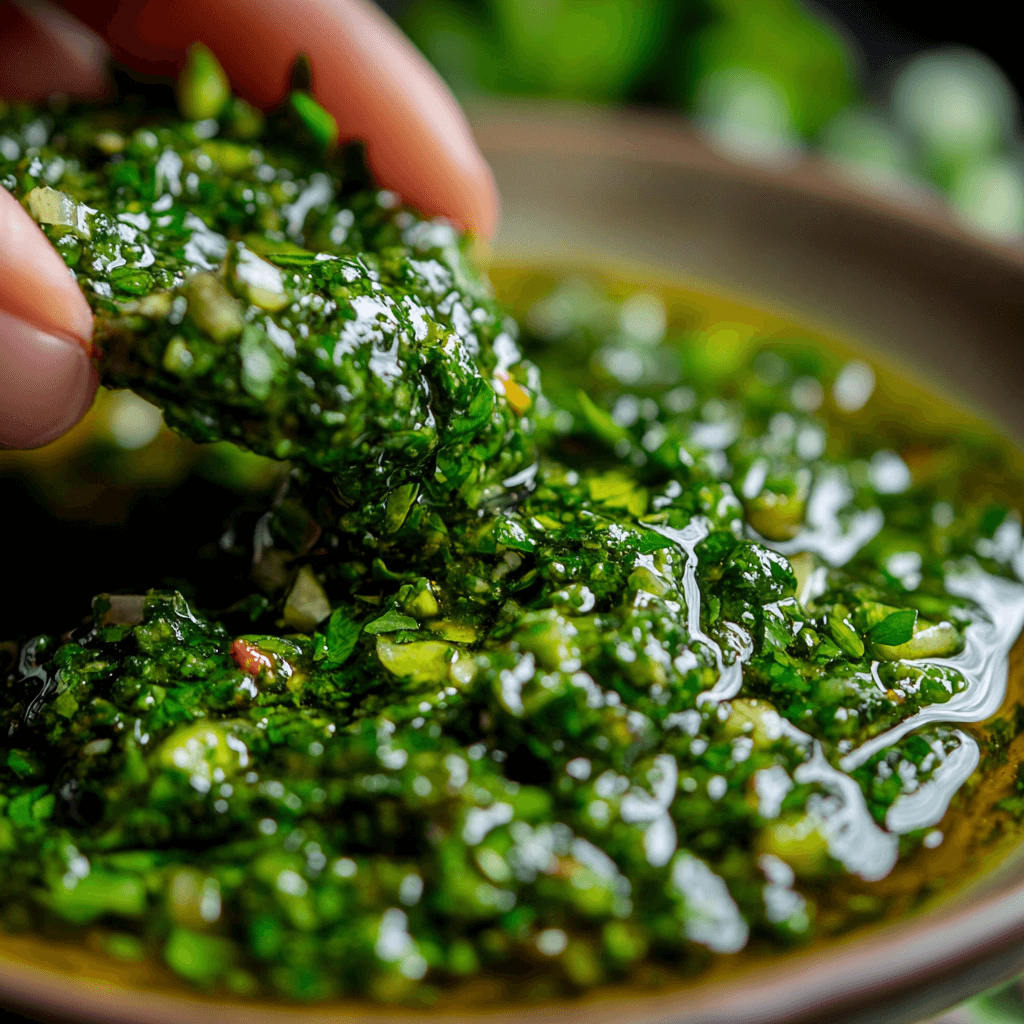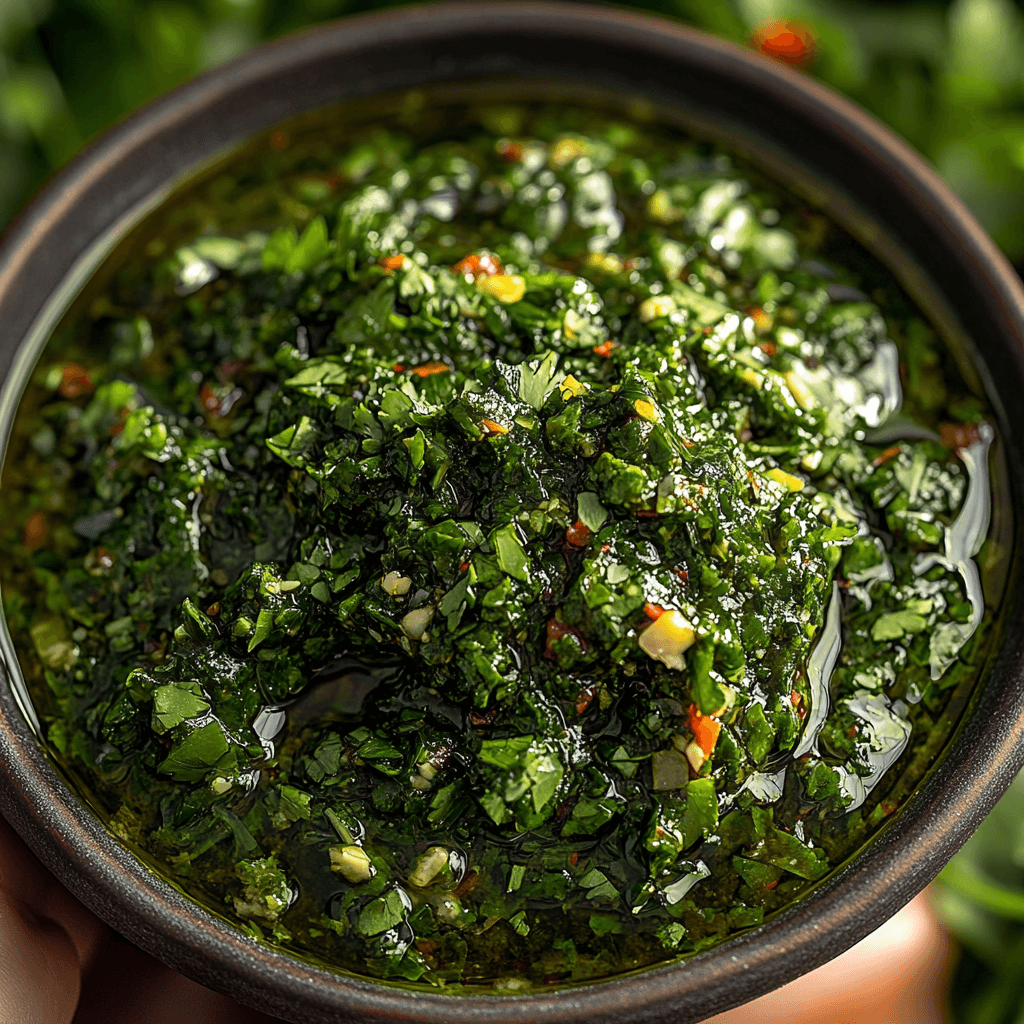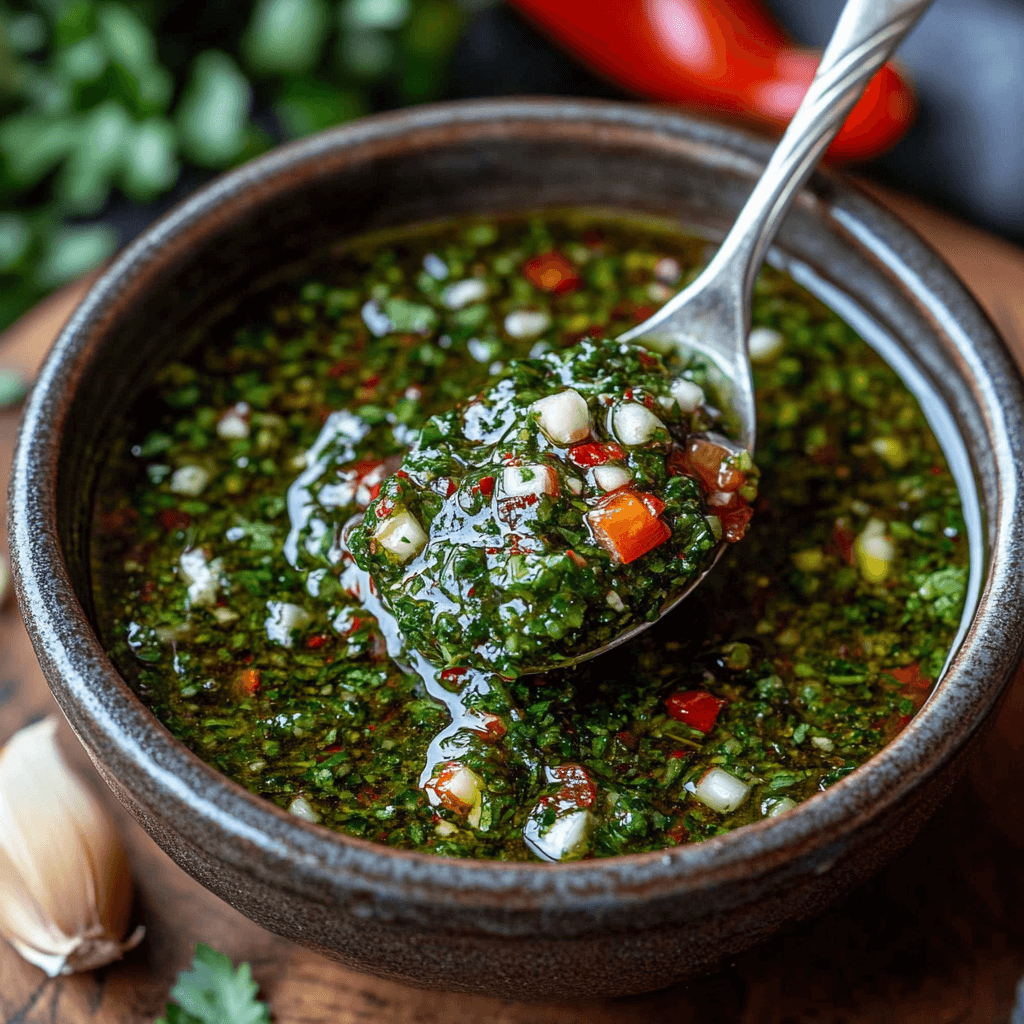There’s something undeniably captivating about a vibrant green sauce that can elevate any dish. Homemade chimichurri sauce is a culinary gem from Argentina, celebrated for its refreshing blend of herbs, garlic, and tangy vinegar that dances gracefully on grilled meats and vegetables alike. Its versatility is one of its most alluring features; whether you’re looking to make a classic version with parsley and oregano or a more whimsical take incorporating cilantro or red pepper flakes, the possibilities are endless.
To achieve that perfect balance of flavor, consider substituting different oils or adding a hint of citrus zest for an extra zing. A little patience goes a long way, allowing the sauce to marinate brings all those rich flavors to life. So, grab your chopping board and let’s explore the mouthwatering world of this cherished condiment, perfect for any summer barbecue or cozy dinner. You’ll soon discover that making this sauce from scratch is not only easy but also a delightful way to impress family and friends!
Ingredients for Homemade Chimichurri Sauce:
Creating your own chimichurri sauce at home is not only simple but also incredibly rewarding. Ideal for marinating meats or drizzling over grilled vegetables, this lively sauce is packed with flavor. Below is a detailed list of the ingredients you’ll need to serve 8–10 people.

Fresh Ingredients
- Fresh Parsley: 1 cup, finely chopped. Use flat-leaf parsley for the best flavor.
- Fresh Oregano: 1/2 cup, finely chopped. Fresh oregano adds a wonderful earthiness.
- Garlic: 6 cloves, minced. Adjust based on your garlic preference; roasted garlic is a sweeter alternative.
- Red Chili Flakes: 1 teaspoon. For a bit of heat, you can increase this to your taste.
Liquid Ingredients
- Red Wine Vinegar: 1/2 cup. This acidity complements the herbs beautifully.
- Extra Virgin Olive Oil: 1 cup. Choose a high-quality oil for the best flavor.
- Lemon Juice: 2 tablespoons, freshly squeezed. This will add a bright note to the sauce.
Seasoning
- Salt: 1 teaspoon. Adjust according to your taste preferences.
- Black Pepper: 1/2 teaspoon, freshly ground. This enhances all the flavors.
Optional Add-Ins and Variations
- Cilantro: Substitute half of the parsley with fresh cilantro for a more complex flavor profile.
- Capers: 2 tablespoons, finely chopped. This adds a briny twist to the sauce.
- Shallots: Replace garlic with 1/4 cup of finely chopped shallots for a sweeter flavor.
This vibrant blend of herbs, acid, and oil comes together to create a robust sauce that enhances a variety of dishes. Whether you’re enjoying a summer barbecue or a cozy family dinner, chimichurri brings a burst of flavor that’s hard to resist!
How to prepare Homemade chimichurri sauce:
Creating your own chimichurri sauce is simple and rewarding. Follow these clear steps to make a fresh, vibrant sauce that enhances any dish.
Gather Your Ingredients
First, collect all the necessary ingredients. You will need fresh parsley, garlic, red wine vinegar, olive oil, dried oregano, crushed red pepper, and salt. Make sure to choose high-quality components for the best flavor.
Chop the Parsley
Next, rinse the parsley under cold water to remove any dirt. Pat it dry with a clean kitchen towel. Then, finely chop about one cup of fresh parsley leaves. The finer you chop, the more flavors will infuse into your sauce.
Prepare the Garlic
Peel four cloves of garlic and finely mince them. Be careful to ensure that there are no large chunks, as they can overpower the overall taste. Add the minced garlic to your mixing bowl.
Add Vinegar and Olive Oil
Pour in half a cup of red wine vinegar into your bowl. This ingredient provides tanginess that complements the richness of the olive oil, which should be added next. Measure out one cup of extra virgin olive oil and slowly drizzle it into the mixture.
Incorporate Dried Oregano
Add two teaspoons of dried oregano to the mixture. Dried herbs like oregano bring a depth of flavor that weaves beautifully into the sauce. Stir well to combine all the ingredients.
Season with Red Pepper and Salt
Sprinkle in half a teaspoon of crushed red pepper for a touch of heat. Follow this with a pinch of salt to elevate the flavors. Adjust the amounts based on your taste preferences. Stir again to ensure everything is evenly distributed.

Let It Rest
After mixing everything together, cover the bowl with plastic wrap or a lid. Allow the chimichurri sauce to rest at room temperature for at least 30 minutes. This resting period helps the flavors meld beautifully.
Serve or Store
Lastly, taste your sauce before serving. Adjust the seasoning if needed. You can serve your chimichurri immediately or store it in an airtight container in the refrigerator for up to one week. Enjoy your flavorful creation!
Tips for the Perfect Homemade Chimichurri Sauce
Creating a vibrant and flavorful chimichurri sauce starts with understanding a few key elements. Here are some essential tips to elevate your sauce to perfection.
Use Quality Ingredients
Quality ingredients make a significant difference in the flavor profile of your chimichurri. Opt for fresh parsley, as it forms the base of the sauce. Look for deep green leaves without wilting or browning. Fresh garlic is another must; its raw aroma adds a pungent kick. Consider using additional herbs like cilantro or oregano for a unique twist. Always choose high-quality olive oil, as it forms the bulk of the sauce. Extra virgin olive oil offers rich flavors that enhance each element. Don’t skimp on the acidity; fresh lemon juice or vinegar brightens up the sauce.
Maintaining the Correct Temperature
Temperature plays a crucial role in making the flavors of chimichurri pop. If you are using fresh herbs, chop them at room temperature to release more oils and aroma. Let your sauce sit at room temperature for about 30 minutes before serving; this resting period allows the flavors to meld beautifully. If you refrigerate your chimichurri, take it out about 15-20 minutes before use, allowing it to warm slightly for a more vibrant taste.
Suitable Substitutions for Dietary Restrictions
If you have dietary restrictions, chimichurri is wonderfully adaptable. For a gluten-free option, ensure any vinegar used is certified gluten-free. Those avoiding garlic can replace it with shallots, offering a milder flavor. If you prefer a nut-free option, make sure your seasoning does not contain any hidden nut ingredients. Vegan and vegetarian diets can enjoy this sauce without any changes, as it is naturally free from animal products.

Additional Flavor Variations
Don’t be afraid to customize your chimichurri! Add red pepper flakes for heat or a bit of smoked paprika for a smoky twist. For a sweeter version, try adding some finely chopped roasted red peppers or sun-dried tomatoes. Experimentation is key; feel free to modify the acidity level to suit your taste preferences. Balancing the ingredients will help create a chimichurri sauce that’s truly your own.
By focusing on fresh, high-quality ingredients and considering these helpful tips, you can craft a delightful chimichurri that elevates any dish.
Storage Tips for Homemade Chimichurri Sauce:
Maintaining Freshness
To keep your homemade chimichurri sauce fresh, always start with clean utensils. Avoid using fingers or dirty spoons that could introduce bacteria. Always store the sauce in an airtight container to minimize exposure to air, which can lead to oxidation and degradation of flavor. A glass jar works best, but plastic containers are also acceptable.
Optimal Storage Conditions
Refrigerate chimichurri sauce as soon as you’re done using it. Keeping it chilled slows down the growth of bacteria. The ideal temperature for storing your sauce is between 32°F to 40°F (0°C to 4°C). Make sure the container is well-sealed before placing it in the fridge to prevent any odor absorption from other foods.
Shelf Life Information
When stored correctly, chimichurri sauce should remain fresh for up to two weeks in the refrigerator. After that period, the flavors may start to dull and the freshness can diminish significantly. If you notice any changes in color, texture, or smell, it’s best to discard the sauce.
Long-Term Storage Options
If you want to keep your chimichurri sauce for longer, consider freezing it. Portion the sauce into ice cube trays to create individual servings. Once frozen, transfer the cubes into a freezer-safe bag. This method allows you to thaw only what you need for each meal. The sauce can last up to six months in the freezer without losing its rich flavors.
Thawing and Using Frozen Sauce
To thaw frozen chimichurri sauce, simply place the cubes in the refrigerator overnight or pop them in the microwave for a quick defrost. Avoid refreezing any thawed sauce to maintain its quality and taste.
By following these storage tips, you can enjoy your homemade chimichurri sauce at its flavorful best every time you use it. Preserve the freshness and delight your taste buds with each serving!
Related Recipes to Complement Homemade Chimichurri Sauce
Homemade chimichurri sauce adds a burst of flavor to many dishes. Here are some delicious recipes that pair well with it, enhancing your meals.
One great option is grilled steak. The rich, meaty flavor of the steak harmonizes beautifully with the fresh herbiness of chimichurri. The sauce cuts through the fat, offering a refreshing contrast. Simply grill your steak to your preferred doneness and drizzle the chimichurri on top before serving.
Another complementary dish is roasted vegetables. The bright, zesty notes in chimichurri elevate the earthy flavors of vegetables like bell peppers, zucchini, and eggplant. Toss the veggies in a bit of olive oil, roast them until tender, and serve alongside your sauce as a dipping option or drizzling it over the top.
If you’re in the mood for seafood, consider making grilled shrimp. The light and slightly sweet taste of shrimp pairs exceptionally well with the tangy and herbaceous notes of chimichurri. Skewer the shrimp, grill until cooked through, and generously apply the sauce for a delightful treat.
Lastly, a fresh salad can also benefit from the vibrant flavors of chimichurri. Use it as a dressing for mixed greens, avocado, and tomatoes. The sauce adds a zesty kick, turning a simple salad into a flavorful dish.
These recipes not only complement the freshness of chimichurri sauce but also showcase its versatility. Enjoy experimenting with these dishes and discovering new ways to elevate your meals!
Frequently Asked Questions:
What is homemade chimichurri sauce made of?
Homemade chimichurri sauce is a vibrant, herbaceous condiment traditionally made with fresh parsley, garlic, vinegar, olive oil, and spices. While the classic version emphasizes parsley, variations can include cilantro or oregano, creating a unique flavor profile. This delightful blend is often used to enhance grilled meats, vegetables, or as a dipping sauce.
How long does homemade chimichurri sauce last?
When stored properly in an airtight container in the refrigerator, your freshly prepared chimichurri can last up to two weeks. Over time, the flavors may meld and intensify, making it even more delicious. However, it’s essential to check for any signs of spoilage, especially if left out at room temperature for prolonged periods.
Can I freeze chimichurri sauce?
Yes, you can freeze your version of this zesty condiment for future use. Simply portion it into ice cube trays or small containers, and once frozen, transfer the individual portions to a freezer bag. This method allows you to enjoy homemade chimichurri sauce at a later date without sacrificing flavor.
Is homemade chimichurri sauce healthy?
Indeed, chimichurri made from fresh herbs and healthy fats from olive oil is a nutritious addition to various dishes. With its antioxidant-rich ingredients, it can enhance flavor without needing heavy marinades or sauces, promoting a balanced diet while enhancing your meals.
What dishes pair well with chimichurri sauce?
This vibrant sauce pairs exceptionally well with grilled meats, such as steak, chicken, or fish. It also complements roasted vegetables and can elevate a simple salad, providing a fresh and zesty contrast. Additionally, it serves as a tasty dipping sauce for bread, making it versatile for many culinary creations.
Can I customize my chimichurri sauce recipe?
Absolutely! One of the best aspects of homemade chimichurri is its versatility. You can experiment with the herbs, adjust the level of garlic, or add red pepper flakes for a spicy kick. Feel free to adapt your version according to your flavor preferences, ensuring a personalized touch to this classic sauce.

Conclusion:
Creating your own homemade chimichurri sauce offers an exciting culinary adventure that enhances any dish. Its preparation is quick and easy, requiring minimal ingredients, yet delivers bold flavors that elevate meats, vegetables, and more. One of the standout features of this sauce is its versatility; feel free to experiment with fresh herbs like oregano and basil or adjust the garlic and acidity to suit your palate. The customization options make it a favorite among food enthusiasts, allowing for a uniquely personal touch. Remember, whether it’s the traditional parsley base or a zesty twist with cilantro, this sauce can adapt to your tastes. Next time you’re grilling or serving up a hearty dish, reach for your homemade chimichurri sauce – it’s the perfect finishing touch that will impress your guests and keep them coming back for more!

